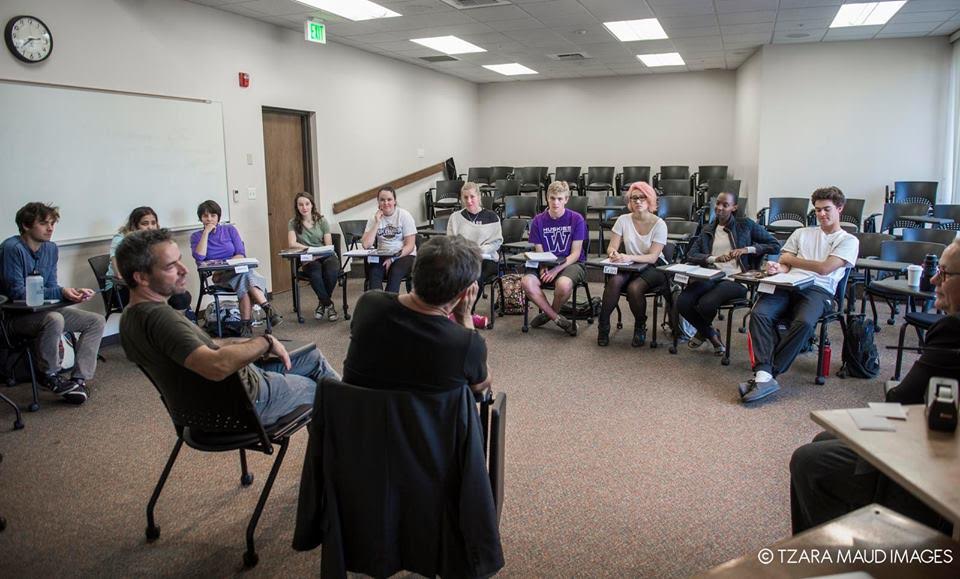French students learn l’art de la bande dessinée with graphic novel exhibition
By Gillian Frew

The French term for comic is bande dessinée—literally, "drawn strip"—and it refers to a specific artistic tradition popularized in early-1900s France and Belgium and eagerly embraced in Quebec, where modern day authors and cartoonists have made the medium their own.
In 2006, Montreal-based artists Régis Loisel, Jean-Louis Tripp and François Lapierre published the first of nine installments of their ambitious bande dessinée series, Magasin général ("General Store"). Completed in 2014, it explores the lifecycle of a small Québécois village in the 1920s. And for students in Associate Professor of French Sarah Hurlburt's 300-level course last semester, it was a key part of the curriculum.

"Her excitement about showing us something that she loves and that neatly fits into the coursework enhanced the experience so wonderfully," said Bailey Super '19.
"I never thought I'd be learning about comic books in my French class."
Hurlburt is an expert on Magasin général, having written several scholarly articles about the series, as well as the introduction to one edition of initial page drawings. Last fall, she curated a section of the popular Seeing Stories exhibition in Whitman's Sheehan Gallery devoted entirely to bande dessinée.
"I approached my portion of it with a very pedagogical goal. The section on Magasin général was meant to help you learn how to read graphic novels, and then that fed back into the main room of the exhibit," she said. "We went with a strong visual contrast between the Magasin général space and the rest of the space."
The alcoves inhabited by Hurlburt's work (and much of it was hers—about half her personal collection, to be precise) certainly did stand out from the rest of the show, which included work by renowned American cartoonists like Joe Sacco, Craig Thompson and Alison Bechdel.
That was intentional, she said.
"As the only example of foreign language comics in the exhibit, I wanted this to be a different space, culturally a different space. I didn't want people to forget that this was not an English language comic. I didn't want them to be so immersed that they forgot they were somewhere else. I wanted it to be accessible, but still with that reminder that no, you are not in Kansas."
Hurlburt hoped visiting the gallery would give her students a greater appreciation for the lexis of French comics beyond genre staples like Tintin and Asterix, "which are the ones that an American might have encountered."
"The first day we went in, everybody was supposed to pick a book, and then they were supposed to read in groups of three," she said. "Then they traded the books in their groups, and we spent the rest of the class discussing the different styles, impressions and what they had learned from it."
Christine Schoeggl '19 said, "It was really cool to see bande dessinée juxtaposed against our concept of comics, and to see how those fit together."

To further enhance her students' appreciation for the material, Hurlburt also arranged for two of the Magasin général artists, Tripp and Lapierre, to come to campus. Their trip was made possible by the O'Donnell Visiting Educators Endowment.
"It was so cool that these two super chic French Canadian guys actually came to our classroom and sat with us in our wheelie chairs and answered our questions and told jokes and talked to us in French," Super said.
In comments later translated by Hurlburt, Tripp remarked on the Seeing Stories exhibition and his experience at Whitman.
"The Sheehan Gallery exhibit was the first time I'd ever seen a graphic novel exhibit incorporate this teaching element," he said. "The fact that the show took place in the context of a college campus brought logic and coherence to this approach. Personally, I think this critical work is essential. It is precisely what is still needed in order for bande dessinée to come into its own as an art form, on par with literature or film."
For Hurlburt, integrating the exhibit into her language class was a way of making the world feel a little bit smaller.
"Students studying French in Walla Walla, Washington, feel pretty far away from France or any Francophone area," she said. "I think things like this exhibit, like getting to meet the authors, like interacting with native speakers, hopefully show that being in France isn't the only way you can make French ‘real.' Learning a language isn't nearly as geographically limited as it used to be, and it changes the way you experience the world wherever you are."